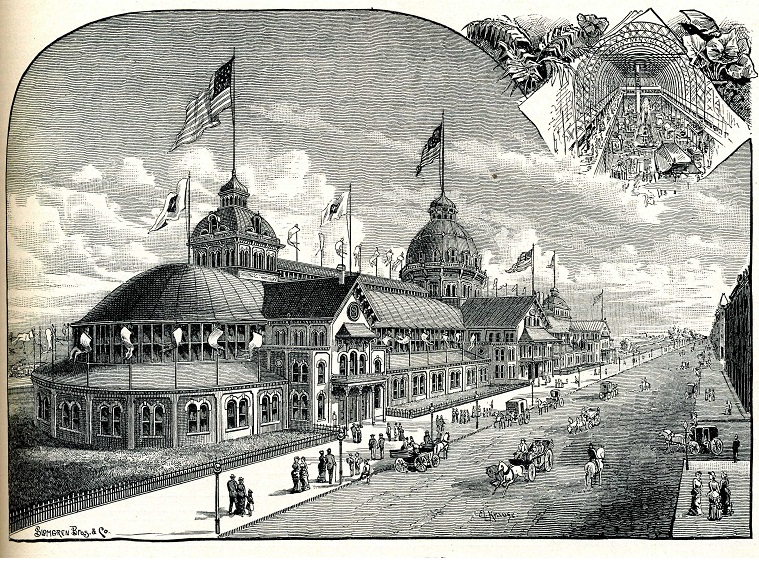Previous: History of Grant Park, 1830-1871
The lagoon between Michigan Avenue and the railroad tracks provided a convenient dumping place for demolition debris after the Great Chicago Fire of 1871.
The 1879 map shows Lake Front Park extending south to 12th Street. The lagoon had been filled in and an Exposition Building built south of Madison. It also appeared that the Illinois Central tracks had moved a little farther out in the lake. North of Randolph, the Illinois Central Depot and yards continued to expand.
In 1887 Montgomery Ward moved his headquarters to Michigan Avenue near Madison. He began suing and agitating to keep the lakefront in front of his office “open, free and clear.” The Robinson's Atlas of the City of Chicago, Illinois provides the most detailed map showing what he saw. There was a two-block-long Exposition Building, a fire house, a building housing an artillery regiment and another for a cavalry regiment. In front of his office were at least 20 sets of tracks.
The online Robinson's Atlas is possible to scale fairly accurately. I figured Michigan Avenue at Harrison was about 100 feet wide including sidewalks. The original plat shows 120 feet. Beyond that Lake Park, occupies 300 feet, the Illinois Central has 8 tracks occupying 100 feet and finally there is 100 feet of land beyond the tracks with small docks sticking out. This means that about 500 feet of lake beyond Michigan Avenue had been filled. Also, the Illinois Central had been enlarging its share.
I used the National Map to measure the distances today. Michigan Avenue is shown as about 120 feet wide. Beyond is about 270 feet of Grant Park. The railroad has four tracks and a busway, occupying 200 feet. Beyond that is around 1650 feet occupied by park and roads. Therefore, today there is about 2150 feet of lakefill-1650 feet of which has occurred since 1896.
The Army Corps of Engineers reported in 1891 that the area of Lake Michigan behind the breakwater was unsuited for large commercial vessels. The outer harbor's only purpose was to provide shelter for pleasure vessels and protect the Illinois Central property. The Corps recommended suspending future dredging and maintenance. Despite this accurate view of the future, Congress continued to allocate money for the outer harbor.
In 1893, Chicago hosted the World’s Columbian Exposition. In preparation, the area east of Michigan Avenue underwent two large changes. The 1873 Exposition Building in Lake Park was torn down in 1891 to make way for the new Art Institute, opened in 1893. Montgomery Ward gave grudging assent to this new obstruction.
The Illinois Central built a new passenger depot just south of 12th Street. The old depot was closed and long distance passenger service discontinued north of 12th. Commuter trains, a huge freight business and all of the tracks remained.
In 1895, the City Council agreed with the Illinois Central on the division of lands east of Michigan Avenue. They also reached an agreement with the Secretary of War (Army Corps of Engineers) which allowed the filling of the lake to the dock line which was approximately 1300 feet east of the shoreline. This is approximately 350 west of the current shoreline, or about where the west line of Lake Shore Drive is today.
In 1896, the City Council gave control of part of Lake Park to the South Park Commissioners, a separate local government. The Commissioners got the area south of Jackson and all of the “lands” east of the Illinois Central tracks.
These “lands” were, except for a narrow strip, underwater. However in the same year a bulkhead was built 1300 feet out in the lake and filling began behind it. The area to be filled was 185 acres, or 0.29 square miles.
The Commissioners were required to dedicate a 900 by 1300 foot strip of the underwater “lands” to the Field Museum—location undefined. This land was never dedicated due to Montgomery Ward’s opposition.
A triangular portion north of Monroe was dedicated to the National Guard for use as an armory. This was not uncommon, several parks have armories, but it would delay park development for 80 years in this area.
In the 1890s, the City Council began requiring railroads to elevate their tracks in order to allow traffic to pass. This did not happen in Grant Park. Instead the Illinois Central Railroad has always been encouraged to keep their tracks as low as possible, while traffic passes overhead.
For more information on the development of Lake Park, my colleague amkjen has prepared a booklist.






Add a comment to: History of Grant Park, 1872-1899